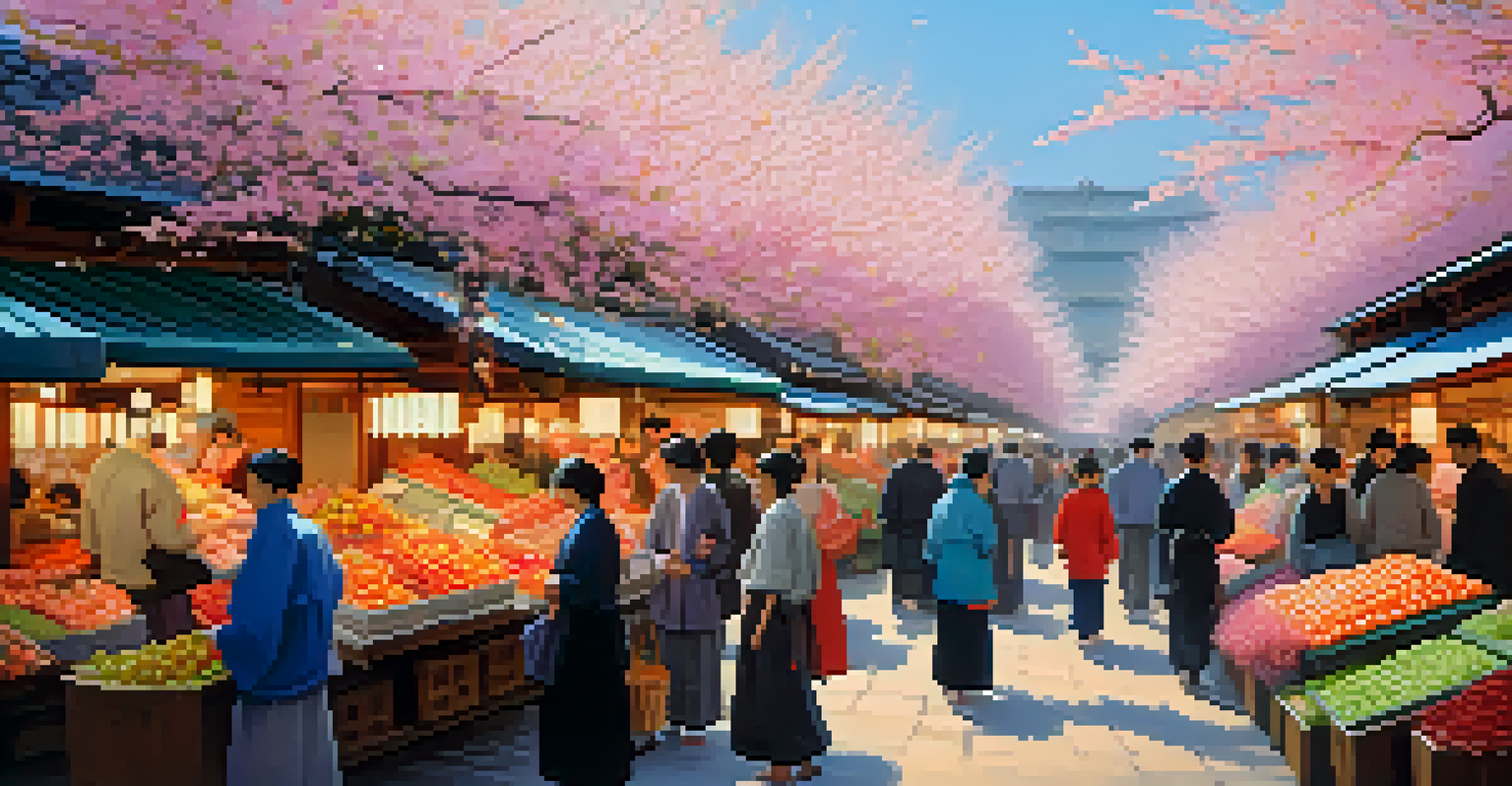The Legacy of Impressionism in Asian Painting Traditions

Understanding Impressionism and Its Core Principles
Impressionism emerged in the late 19th century, primarily in France, emphasizing light, color, and the fleeting moments of everyday life. Artists like Claude Monet and Edgar Degas broke away from traditional techniques, opting for loose brushwork and vibrant palettes. This movement encouraged painters to capture the essence of a scene rather than its precise details, focusing on the perception of light at different times of day.
Impressionism is not a style; it is a way of seeing.
The core principles of Impressionism—such as spontaneity and an emphasis on natural light—resonated with various artistic traditions across the globe. While the movement was rooted in European culture, its ripple effects reached far into Asia, influencing local artists and their interpretations of traditional themes. This cross-pollination of ideas led to a fascinating blend of styles, colors, and techniques in Asian painting.
As Impressionism spread, it sparked a dialogue between Western and Eastern artists, creating a unique fusion that enriched both traditions. Asian painters began experimenting with new approaches while still holding onto their cultural roots. The dialogue between these two worlds is a testament to the universal language of art that transcends geographical boundaries.
The Impact of Impressionism on Japanese Painting
Japan, with its rich artistic heritage, became a significant player in the Impressionist movement during the late 19th and early 20th centuries. Artists like Yokohama-based painters began incorporating Western techniques into their work, blending traditional Japanese aesthetics with Impressionist ideals. This fusion led to a new genre known as 'Yōga,' which translated to 'Western painting' in Japanese.

One notable example is the work of painter and printmaker Tsuguharu Foujita, who seamlessly blended Western styles with Japanese subjects. His paintings captured the play of light and shadow, resonating with the core tenets of Impressionism while celebrating Japanese culture. This cultural exchange not only broadened the horizons for individual artists but also contributed to a wider acceptance of Western art forms in Japan.
Impressionism's Global Influence
The Impressionist movement transcended its European roots, significantly impacting Asian art by inspiring unique fusions of traditional and Western techniques.
The legacy of Impressionism in Japanese painting is evident in the way artists embraced color, light, and innovative compositions. These influences can still be seen in contemporary Japanese art, where traditional motifs coexist with modern techniques. The conversation between East and West continues to inspire new generations of artists.
Chinese Artists Embracing Impressionism
In China, the introduction of Impressionism coincided with a period of significant change and modernization. Artists began to explore new methods of expression that aligned with their evolving cultural identity. The blending of Impressionist techniques with traditional Chinese painting created a vibrant dialogue that transformed the art scene in China.
The painter tries to master the art of painting; the Impressionist tries to master the art of seeing.
Prominent figures like Xu Beihong played a crucial role in this artistic evolution. He combined Western realism and Impressionist influences with traditional Chinese ink painting, resulting in stunning works that conveyed both emotion and cultural significance. This blend allowed artists to express their unique perspectives while still paying homage to their heritage.
Today, the influence of Impressionism remains evident in Chinese art, where contemporary artists continue to push boundaries. The legacy of this movement encourages experimentation and personal expression, resulting in a diverse range of styles that reflect both historical and modern themes. This ongoing exploration highlights the dynamic relationship between tradition and innovation in Chinese painting.
The Role of Impressionism in Indian Art
In India, the arrival of Impressionism coincided with a surge of nationalistic pride in the late 19th and early 20th centuries. Artists like Raja Ravi Varma began incorporating new techniques into their works, blending Western influences with Indian themes. This led to a reimagining of traditional subjects through the lens of Impressionism, emphasizing vibrant colors and emotional depth.
The movement also inspired a group of artists known as the Bengal School, who sought to create a uniquely Indian style. They combined Impressionist elements with local folk traditions and motifs, resulting in a rich tapestry of artistic expression. This fusion allowed Indian artists to assert their cultural identity while engaging with global art movements.
Cultural Exchange in Art
The dialogue between Eastern and Western artists led to innovative styles that celebrated both cultural heritage and modern artistic expression.
Today, the legacy of Impressionism can be seen in the works of contemporary Indian artists who continue to explore this dialogue between East and West. The influence of light, color, and emotional expression remains strong, as artists draw inspiration from both their cultural heritage and the broader art world. This ongoing evolution reflects the dynamic nature of art in India.
Comparative Analysis of Techniques: East Meets West
One of the most fascinating aspects of the Impressionist legacy in Asian painting is the comparative analysis of techniques between Eastern and Western artists. While Impressionism emphasizes capturing light and movement, traditional Asian painting often focuses on harmony and balance. This juxtaposition creates a rich landscape for artistic exploration, where each tradition can inform and enhance the other.
For example, the controlled brushstrokes of Chinese calligraphy have found their way into Impressionist-inspired works, creating a unique blend of precision and spontaneity. Japanese woodblock prints, known for their flat colors and dynamic compositions, also influenced Western Impressionists, showcasing how these two worlds can merge to create something entirely new.
This cross-cultural exchange highlights the importance of dialogue in art, where techniques and ideas are continuously evolving. By examining the differences and similarities between Eastern and Western painting traditions, artists can draw inspiration from both sides, ultimately pushing the boundaries of their creativity. The result is a vibrant, interconnected art scene that celebrates diversity and innovation.
Modern Asian Artists Influenced by Impressionism
Today, many contemporary Asian artists carry forward the legacy of Impressionism, using its principles to inform their work while also exploring personal narratives. Artists like Takashi Murakami and Ai Weiwei draw on the techniques and philosophies of Impressionism, each in their unique way. By blending these influences with their cultural contexts, they create art that resonates on multiple levels.
Murakami, known for his colorful, pop-infused works, often incorporates themes of consumerism and traditional Japanese aesthetics, reflecting a modern interpretation of Impressionist ideas. Meanwhile, Ai Weiwei uses his art as a powerful form of social commentary, infusing his works with emotional depth and urgency reminiscent of the Impressionist focus on capturing the moment.
Modern Artists and Impressionism
Contemporary Asian artists continue to draw inspiration from Impressionism, blending its principles with personal narratives to create resonant and relevant art.
The influence of Impressionism on modern Asian artists underscores the movement's lasting impact on global art. These artists continue to reinterpret and innovate upon Impressionist techniques, ensuring that the dialogue between cultures remains vibrant and relevant. As they navigate their unique artistic journeys, they contribute to a rich legacy that honors the past while looking toward the future.
Conclusion: The Enduring Influence of Impressionism
The legacy of Impressionism extends far beyond its origins in Europe, creating an enduring impact on Asian painting traditions. This movement ignited a cultural exchange that encouraged artists to explore new techniques while remaining rooted in their heritage. The interplay between East and West has given rise to a diverse range of artistic expressions that celebrate both individuality and shared experiences.
As we reflect on the influence of Impressionism, it's clear that its principles continue to inspire artists across the globe. The focus on light, color, and emotion resonates with the core values of many Asian painting traditions, allowing for a rich tapestry of creativity that transcends borders. This ongoing dialogue ensures that the spirit of Impressionism remains alive and vibrant in contemporary art.

In conclusion, the legacy of Impressionism serves as a powerful reminder of art's ability to connect people and cultures. By embracing the lessons of the past while forging new paths, artists can create works that reflect the complexity and beauty of our shared human experience. The future of art is bright, as the influences of Impressionism continue to inspire and shape the artistic landscape in Asia and beyond.